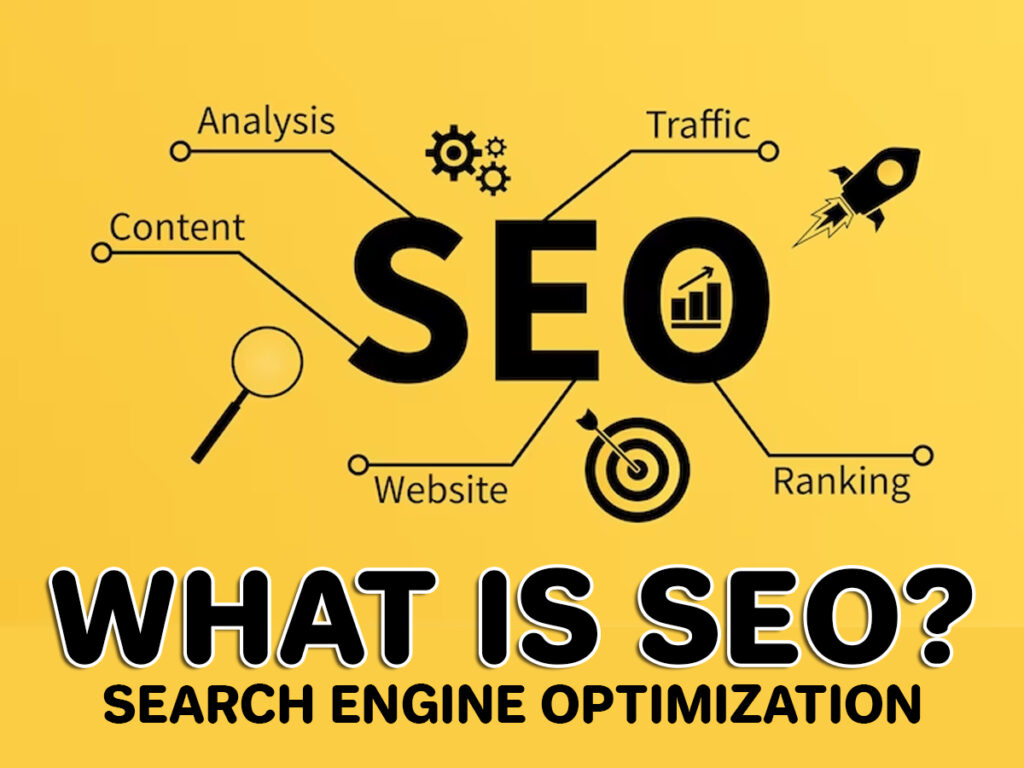SEO (Search Engine Optimization) is the most common way of upgrading a site or site page to build its permeability and positioning on web crawler result pages (SERPs) for explicit watchwords and expressions.
The point of Web optimization is to draw in natural, non-paid traffic to a site by making it more noticeable and available to clients who are looking for significant data or items on the web.

There are two fundamental kinds of SEO: on-page SEO and off-page SEO refers to the optimization of the website’s content and structure, including title tags, meta descriptions, header tags, internal linking, and keyword optimization. Off-page SEO, on the other hand, refers to the optimization of external factors that affect a website’s visibility, such as backlinks, social media signals, and online reputation. The Best Simple and Free SEO Tools – Why You Should Use
Search engine optimization is significant for organizations and site proprietors since it assists them with expanding their web-based permeability, drive more traffic to their site, and produce leads or deals. By implementing SEO best practices, businesses can improve their online presence and compete more effectively in their market.
From an overall perspective, an aide on Website design enhancement might cover the accompanying subjects:
- Understanding the rudiments of SEO, including what it is and the way that it works..
- Conducting keyword research to identify relevant and high-traffic search terms.
- On-page SEO techniques, such as optimizing title tags, meta descriptions, header tags, and content.
- Off-page SEO techniques, such as building high-quality backlinks and social media signals.
- Local SEO strategies, including optimizing for local search and Google My Business listings.
- Technical SEO considerations, such as website structure, page speed, and mobile responsiveness.
- Measuring and tracking SEO performance using tools like Google Analytics and Google Search Console.
- Common SEO mistakes to avoid and best practices to follow.
- Keeping awake to-date with the most recent Website optimization patterns and calculation refreshes.
Generally, an aide on Web optimization intends to give a complete comprehension of the methodologies and procedures that can assist organizations and site proprietors with working on their internet based perceivability and drive more traffic to their site.
How is SEO different from SEM and PPC?
SEO, SEM, and PPC are all related to search engine marketing, but they are different techniques with unique objectives and strategies.
SEO, as explained earlier, is the process of optimizing a website’s content and structure to improve its visibility and ranking on search engine results pages (SERPs) for specific keywords and phrases. The aim of SEO is to attract organic, non-paid traffic to a website.
SEM (Search Engine Marketing) alludes to any advertising action that includes the utilization of web search tools to advance a site or item. It encompasses both SEO and paid search marketing. SEM is the umbrella term for all search engine marketing activities, including SEO, PPC, and other related strategies.
PPC (Pay-Per-Click) is a form of online advertising where businesses bid on specific keywords and phrases to display ads in the sponsored results section of search engine results pages. Promoters pay a charge each time somebody taps on their promotion. The aim of PPC is to drive targeted traffic to a website quickly, but it requires a budget to run.
In summary, SEO is focused on optimizing a website to rank organically in search engine results, while SEM involves all marketing activities that use search engines, including SEO and paid search. PPC is a specific form of paid search advertising where advertisers pay for each click on their ads.
SEO vs SEM
On the other hand, SEM encompasses both SEO and paid search marketing. SEM refers to any marketing activity that involves the use of search engines to promote a website or product. While SEO is focused on improving organic search rankings, paid search marketing, such as PPC (Pay-Per-Click), allows businesses to bid on specific keywords and phrases to display ads in the sponsored results section of search engine results pages. Publicists pay a charge each time somebody taps on their promotion. The aim of SEM is to drive targeted traffic to a website quickly, and it can be more costly than SEO.
In summary, SEO is a long-term, organic approach to improving search engine visibility, while SEM encompasses both SEO and paid search marketing to drive traffic to a website. Both strategies have their advantages and can be used together for a comprehensive search engine marketing strategy.
SEO vs PPC
SEO (Search Engine Optimization) and PPC (Pay-Per-Click) PPC, on the other hand, involves paying to display ads in the sponsored results section of search engine results pages. Advertisers bid on specific keywords and phrases and pay a fee each time someone clicks on their ad. The aim of PPC is to drive targeted traffic to a website quickly. While PPC can be more costly than SEO enhancement temporarily, it can convey quicker results and can be more viable for specific sorts of organizations or businesses. SEO – Search Engine Optimization?
In outline, SEO is a long haul, natural way to deal with further developing web crawler perceivability, while PPC is a paid methodology that conveys quick outcomes. Both strategies have their advantages and can be used together for a comprehensive search engine marketing strategy. Ultimately, the decision to use SEO, PPC, or a combination of both depends on a business’s goals, budget, and target audience.
Why is SEO important?
SEO (Search Engine Optimization) is significant in light of multiple factors, including:
- Increased visibility and traffic: SEO can assist a site with positioning higher on web search tool results pages (SERPs) for explicit watchwords and expressions, which can build its perceivability and draw in more rush hour gridlock to the webpage.
- Cost-effectiveness: Not at all like paid publicizing, Search engine optimization is a practical method for directing people to a site since there is no expense per click or per impression.
- Credibility and trust: High search engine rankings can help to establish a website’s credibility and trustworthiness with potential customers.
- Better user experience: SEO involves optimizing a website’s structure and content for both search engines and users, which can lead to a better user experience and increased engagement.
- Long-term benefits: While Search engine optimization can carve out opportunity to convey results, the advantages can be enduring and keep on directing people to a site over the long run.
- Competitive advantage: A well-executed SEO procedure can assist a site with outclassing its rivals on SERPs and gain an upper hand in the marketplace.
In summary, SEO is important because it can increase a website’s visibility and traffic, establish credibility and trust, provide a better user experience, and deliver long-term benefits and a competitive advantage.
Types of SEO
There are three principal sorts of SEO (Search Engine Optimization):
- On-page SEO: On-page Search engine optimization alludes to the advancement of individual site pages to work on their positioning and pertinence for explicit watchwords. This includes optimizing the page’s content, headings, meta tags, images, and internal links.
- Off-page SEO: Off-page SEO refers to the optimization of external factors that affect a website’s ranking, such as backlinks from other websites, social media signals, and online directory listings. This type of SEO involves building high-quality backlinks to a website to improve its authority and credibility.
- Technical SEO: Technical SEO refers to the optimization of a website’s technical elements to improve its indexing and crawling by search engines. This includes optimizing a website’s site architecture, URL structure, XML sitemap, and robots.txt file, as well as ensuring that the website is mobile-friendly and has fast loading times.
In synopsis, the three fundamental sorts of SEO are on-page Search engine optimization, off-page SEO, and specialized SEO. A comprehensive SEO strategy should incorporate all three types of SEO to improve a website’s visibility and ranking on search engine results pages (SERPs).
How does SEO work?
SEO (Search Engine Optimization) works by optimizing a website’s content, structure, and external factors to improve its ranking and relevance for specific keywords and phrases on search engine results pages (SERPs).
The essential strides of how SEO functions are as per the following:
- Keyword research: Distinguish the Keyword and expressions that your ideal interest group is looking for while searching for items or administrations like yours.
- On-page optimization: Optimize the content, headings, meta tags, images, and internal links on individual web pages to make them more relevant and informative for the target keywords.
- Off-page optimization: Build high-quality backlinks to your website from external sources such as social media, online directories, and other websites to improve its authority and credibility.
- Technical optimization: Optimize the technical elements of your website to improve its indexing and crawling by search engines, such as site architecture, URL structure, XML sitemap, robots.txt file, mobile-friendliness, and loading times.
- Monitor and adjust: Continuously monitor your website’s performance and make adjustments to your SEO strategy based on the results. This may include updating content, building more backlinks, or adjusting technical elements to improve your website’s ranking and visibility.
In summary, SEO works by optimizing a website’s content, structure, and external factors to improve its ranking and relevance for specific keywords and phrases on search engine results pages. It is a continuous process that requires ongoing monitoring and adjustment to ensure continued success.
Understanding how search engines work
To understand how search engines work, it’s important to know that they operate in three main stages: crawling, indexing, and ranking.
- Crawling: Search engines use automated software programs called crawlers or spiders to crawl the web and discover new pages and content. Crawlers follow links from one page to another and gather information about each page they visit, such as the page’s content, structure, and external links.
- Indexing: After the crawlers have discovered and gathered information about a page, the search engine indexes it in its database. The index contains a copy of the content and metadata of each page, which can be searched and retrieved by the search engine’s algorithms.
- Ranking: When a user enters a search query, the search engine’s algorithms analyze the index and determine which pages are most relevant and authoritative for the query. Pages are positioned in view of various elements, including the substance’s importance to the question, the site’s power and believability, and the client’s area and search history.
To determine a page’s relevance to a search query, search engines use complex algorithms that take into account hundreds of factors, including:
- The presence and frequency of keywords and phrases in the content and metadata of the page.
- The quality and quantity of backlinks pointing to the page from other authoritative websites.
- The relevance and freshness of the page’s content to the search query.
- The website’s overall authority, credibility, and reputation.
In outline, web search tools work by creeping the web to find and record content, and afterward positioning that content in view of various variables to decide its pertinence and authority for a given pursuit question.
Researching
SEO researching involves conducting research to identify keywords, topics, and content that can help improve a website’s visibility and ranking on search engine results pages (SERPs). The objective of SEO is to distinguish what potential clients are looking for and how they are looking for it, with the goal that site proprietors can upgrade their substance to all the more likely match those search questions.
The essential advances engaged with SEO researching are:
- Keyword research: Recognize the most pertinent and high-traffic catchphrases and expressions for your business or industry utilizing catchphrase research devices like Google Keyword Planner, SEMrush, Ahrefs, or Moz.
- Competitive analysis: Examine the sites and content of your top rivals to distinguish their assets and shortcomings, and to acquire experiences into their SEO strategies.
- Content analysis: Analyze your website’s existing content to identify gaps in the content and to identify opportunities to optimize content for target keywords.
- Link analysis: Analyze the quality and quantity of backlinks pointing to your website and your competitors’ websites to identify opportunities to build high-quality backlinks and improve your website’s authority and credibility.
- Technical analysis: Analyze the technical elements of your website, such as site architecture, URL structure, and metadata, to identify any issues that may be affecting your website’s indexing and crawling by search engines.
- Monitor and adjust: Continuously monitor your website’s performance and make adjustments to your SEO strategy based on the results. This may include updating content, building more backlinks, or adjusting technical elements to improve your website’s ranking and visibility.
In summary, SEO researching involves conducting research to identify keywords, topics, and content that can help improve a website’s visibility and ranking on search engine results pages. The process involves keyword research, competitive analysis, content analysis, link analysis, technical analysis, and ongoing monitoring and adjustment.
Planning
SEO planning involves creating a comprehensive plan to optimize a website’s visibility and ranking on search engine results pages (SERPs). The objective of SEO arranging is to foster a procedure that tends to the particular requirements and objectives of a site, and to carry out prescribed procedures that will further develop the site’s positioning and perceivability in web crawler results.
The fundamental advances engaged in SEO planning are:
- Define goals and objectives: Distinguish the particular objectives and targets of the site and how SEO can assist with accomplishing those objectives. This could include increasing website traffic, generating leads, or improving online sales.
- Conduct a website audit: Evaluate the website’s current SEO performance, identify technical issues, and assess the quality of the website’s content and backlinks.
- Conduct keyword research: Identify relevant and high-traffic keywords and phrases that align with the website’s goals and objectives.
- Develop an SEO strategy: Develop a far reaching plan that frames the particular strategies and exercises that will be utilized to streamline the site for search engines. This may include optimizing on-page elements such as title tags, meta descriptions, and content, building high-quality backlinks, and improving technical SEO elements.
- Implement and monitor: Implement the SEO strategy and monitor its performance to track progress and identify areas for improvement.
- Continuously optimize: Continuously optimize the website’s SEO strategy based on performance data and changing industry trends and best practices.
In summary, SEO planning involves creating a comprehensive plan to optimize a website’s visibility and ranking on search engine results pages. The process involves defining goals and objectives, conducting a website audit, conducting keyword research, developing an SEO strategy, implementing and monitoring the strategy, and continuously optimizing the strategy based on performance data and industry trends.
Creating and implementing
Creating and implementing an SEO strategy involves putting into action the plan developed during the SEO planning phase. This involves implementing on-page and off-page optimization tactics to improve the website’s visibility and ranking on search engine results pages (SERPs).
The basic steps involved in creating and implementing an SEO strategy are:
- On-page optimization: Optimize the website’s on-page elements, including title tags, meta descriptions, header tags, and content, to ensure they are relevant, high-quality, and optimized for target keywords.
- Technical optimization: Optimize the website’s technical elements, including site structure, URL structure, website speed, and mobile-friendliness, to ensure the website is easily crawlable by search engines and provides a positive user experience.
- Off-page optimization: Build high-quality backlinks to the website from relevant, authoritative websites in the same industry or niche. This can include guest posting, link outreach, and social media promotion.
- Content creation: Develop high-quality, engaging, and relevant content that aligns with target keywords and provides value to the website’s target audience.
- Monitor and measure: Continuously monitor the website’s performance and measure the impact of the SEO strategy on website traffic, ranking, and other key performance indicators.
- Adjust and refine: Make adjustments to the SEO strategy based on performance data and changes in industry best practices to continually improve the website’s ranking and visibility on search engine results pages.
In summary, making and carrying out a Website design enhancement system includes improving on-page and off-page components, growing excellent substance, and ceaselessly checking and refining the technique in view of execution information and industry patterns. By carrying out a compelling Web optimization procedure, a site can work on its perceivability and positioning on web search tool results pages, draw in more designated rush hour gridlock, and accomplish its objectives and goals.
Monitoring and maintaining
Monitoring and maintaining an SEO technique is a fundamental piece of guaranteeing long haul progress in web crawler rankings. As search engine algorithms and best practices are constantly changing, ongoing monitoring and maintenance of an SEO strategy is critical to maintaining or improving the website’s visibility and ranking on search engine results pages (SERPs).
The basic steps involved in monitoring and maintaining an SEO strategy are:
- Regular performance tracking: Regularly monitor key performance indicators such as website traffic, ranking positions, and conversion rates to evaluate the effectiveness of the SEO strategy and identify areas for improvement.
- Ongoing content creation: Continuously develop high-quality, relevant content to keep the website fresh and engaging for both users and search engines.
- Regular website updates: Keep the website updated and technically optimized, ensuring that it meets the latest standards for website structure, mobile-friendliness, and speed.
- Backlink monitoring: Monitor the website’s backlink profile to ensure that all links are relevant, high-quality, and meet search engine guidelines.
- Competitor analysis: Continuously monitor competitor websites and strategies to stay informed about industry trends and adjust the SEO strategy as necessary.
- Regular SEO audits: Conduct regular SEO audits to identify technical issues, content gaps, and opportunities for improvement.
By monitoring and maintaining an SEO strategy, a website can stay competitive in search engine rankings and attract more targeted traffic. This will assist the site with accomplishing its objectives and targets, whether it be expanding site traffic, producing leads, or working on web-based deals.
Analyzing, assessing and reporting on performance
Analyzing, assessing, and providing details regarding execution is a basic piece of any SEO strategy. By evaluating the performance of an SEO campaign, website owners and marketers can make data-driven decisions and continually improve the website’s visibility and ranking on search engine results pages (SERPs).
The essential advances engaged with analyzing, assessing, and reporting an performance are:
- Collect data: Collect data from different sources, for example, site investigation apparatuses, watchword following devices, and backlink observing instruments.
- Analyze data: Analyze the data collected to identify trends, patterns, and insights into the website’s performance.
- Assess the performance: Evaluate the exhibition of the site in view of key execution markers, for example, site traffic, positioning positions, navigate rates, change rates, and bob rates.
- Identify areas for improvement: Identify areas for improvement based on the data and performance analysis.
- Develop an action plan: Develop an action plan to address areas for improvement, including updates to on-page optimization, content creation, and link building.
- Report on performance: Create regular reports that highlight key performance indicators and provide insights into the website’s overall performance.
By analyzing, assessing, and reporting on performance, website owners and marketers can continuously improve the website’s visibility and ranking on search engine results pages. This will assist the site with accomplishing its objectives and targets, whether it be expanding site traffic, creating leads, or working on internet based deals.
SEO is ongoing
Yes, SEO is an ongoing process that requires continuous effort and attention to maintain and improve a website’s visibility and ranking on search engine results pages (SERPs). This is on the grounds that web index calculations and best practices are continually advancing, and new contenders might enter the market out of the blue.
SEO is not a one-time project that can be completed and then forgotten about. Rather, it is a long-term investment that requires ongoing monitoring, maintenance, and improvement to achieve and maintain high rankings and drive targeted traffic to a website.
Ongoing SEO efforts may include regularly creating high-quality, relevant content, conducting keyword research and optimization, monitoring and updating on-page optimization factors, monitoring and improving the website’s backlink profile, staying up-to-date with changes in search engine algorithms and best practices, and continuously analyzing and assessing the website’s performance.
By continually investing in SEO, website owners and marketers can stay competitive in search engine rankings and attract more targeted traffic to their website. This will assist them with accomplishing their business objectives, for example increasing website traffic, generating leads, and improving online sales.
How to learn SEO
Learning SEO requires a combination of knowledge, practice, and ongoing education. Here are a few stages you can take to learn SEO:
- Read industry blogs and articles: Start by understanding articles and sites connected with SEO, for example, Moz, Web search tool Diary, Web index Land, and SEMrush. This will assist you with acquiring a comprehension of the rudiments of Search engine optimization and keep awake to-date with the most recent patterns and best practices.
- Take online courses: There are numerous internet based courses accessible that can assist you with learning SEO. Some popular options include courses on Udemy, Coursera, and HubSpot Academy.
- Attend webinars and conferences: Attending webinars and conferences is an extraordinary method for gaining from specialists in the business and keep awake to-date with the most recent patterns and best practices.
- Practice on your own website: The most ideal way to learn Search engine optimization is to rehearse on your own site. Implement the techniques you have learned and track your website’s performance.
- Use SEO tools: Use SEO tools such as Google Analytics, SEMrush, Ahrefs, and Moz to analyze your website’s performance and gain insights into areas for improvement.
- Join online communities: Join online communities such as forums and social media groups to learn from other SEO professionals and ask questions.
Remember that learning SEO is an ongoing process that requires continuous effort and education. Stay up-to-date with the latest trends and best practices, and keep practicing and experimenting with different techniques to improve your website’s visibility and ranking on search engine results pages.
Search Engine Land’s SEO resources
Search Engine Land is a popular website that provides a wealth of resources and information related to SEO and search engine marketing.
Here are some of the SEO resources available on Search Engine Land:
- SEO Guide: The SEO Guide on Search Engine Land provides a comprehensive overview of the basics of SEO, including keyword research, on-page optimization, link building, and technical SEO.
- News and Analysis: Search Engine Land provides up-to-date news and analysis related to SEO, including updates to search engine algorithms and best practices.
- How-to Guides: Search Engine Land provides step-by-step guides on various aspects of SEO, including content creation, link building, and technical SEO.
- Whitepapers and E-books: Search Engine Land offers a variety of whitepapers and e-books related to SEO and search engine marketing, including guides on local SEO, mobile optimization, and more.
- Webinars and Events: Search Engine Land hosts webinars and events related to SEO and search engine marketing, providing opportunities to learn from experts in the industry.
- Search Engine Land Awards: Search Engine Land hosts an annual awards program to recognize excellence in SEO and search engine marketing.
Overall, Search Engine Land is a great resource for anyone looking to learn more about SEO and stay up-to-date with the latest trends and best practices.
earch Engine Land also has multiple categories on topics dedicated to specific areas and platforms which you may find helpful:
Yes, that’s correct! In addition to the SEO resources I mentioned earlier, Search Engine Land also has multiple categories dedicated to specific areas and platforms related to search engine marketing. These categories include:
- Google: This category covers news, updates, and tips related to Google search, including Google algorithm updates, Google Ads, Google Search Console, and more.
- Bing: This category covers news, updates, and tips related to Bing search, including Bing Ads, Bing Webmaster Tools, and more.
- Local SEO: This category covers topics related to local SEO, including local business listings, local search ranking factors, and more.
- Mobile: This category covers topics related to mobile optimization, including mobile search, mobile-friendly websites, and mobile user experience.
- Social: This category covers topics related to social media and its impact on search engine marketing, including social media advertising and social media optimization.
- Analytics: This category covers topics related to web analytics, including Google Analytics, website tracking, and data analysis.
- SEM: This category covers topics related to search engine marketing (SEM), including paid search advertising, PPC campaigns, and search engine marketing strategies.
These categories provide targeted information and resources for specific areas and platforms related to search engine marketing, making it easier to find information and insights that are relevant to your specific needs and goals.
Search Engine Land’s Guide To SEO
Search Engine Land’s Guide to SEO is a comprehensive resource that covers all aspects of search engine optimization, from the basics to advanced techniques. It is designed to help both beginners and experienced marketers improve their understanding of SEO and apply best practices to their websites.
The guide covers a wide range of topics, including:
- Keyword research: This section covers the importance of keyword research and how to identify the right keywords to target for your website.
- On-page optimization: This section covers best practices for on-page optimization, including optimizing meta tags, header tags, and content.
- Technical SEO: This section covers technical aspects of SEO, including website structure, crawlability, and mobile optimization.
- Link building: This section covers link building strategies and best practices, including how to acquire high-quality backlinks and avoid low-quality links.
- Content marketing: This section covers how to create and optimize content for SEO, including best practices for content creation, distribution, and promotion.
- Local SEO: This section covers how to optimize your website for local search, including local keyword targeting, business listings, and customer reviews.
- Analytics and measurement: This section covers how to use web analytics tools to track and measure the success of your SEO efforts.
Overall, Search Engine Land’s Guide to SEO is a valuable resource for anyone looking to improve their understanding of SEO and implement best practices to improve their website’s visibility in search engines.
Google’s SEO resources
Google has several resources available to help website owners and marketers understand and implement SEO best practices. Some of these resources include:
- Google Search Console: Google Search Console is a free tool that provides website owners with insights into how their site is performing in Google search results. It provides information about search traffic, search queries, crawl errors, and more.
- Google Analytics: Google Analytics is a free web analytics tool that helps website owners understand how users interact with their website. It provides insights into website traffic, user behavior, and conversions.
- Google Webmaster Guidelines: Google Webmaster Guidelines provide recommendations and best practices for website owners to follow in order to optimize their website for Google search.
- Google My Business: Google My Business is a free tool that allows businesses to manage their online presence across Google, including Google Search and Google Maps.
- Google Keyword Planner: Google Keyword Planner is a free tool that helps website owners and marketers identify keywords and phrases that are relevant to their business and can be used in their SEO efforts.
- Google Trends: Google Trends is a free tool that allows website owners and marketers to analyze search data and trends over time.
- Google’s SEO Starter Guide: Google’s SEO Starter Guide is a comprehensive resource that provides an overview of basic SEO principles and best practices.
By using these resources, website owners and marketers can gain insights into their website’s performance, identify areas for improvement, and implement best practices to improve their website’s visibility in Google search results.
Developing your SEO skills
Developing your SEO skills can take time and effort, but there are several steps you can take to improve your understanding and expertise in this field. Here are some tips to help you develop your SEO skills:
- Learn the basics: Start by learning the basics of SEO, including how search engines work, keyword research, on-page optimization, and link building. You can find many online resources to help you get started, including blogs, courses, and tutorials.
- Stay up-to-date: SEO is a constantly evolving field, with new algorithms and best practices emerging all the time. Stay up-to-date with the latest trends and developments by reading industry blogs, attending conferences, and networking with other SEO professionals.
- Practice, practice, practice: The best way to develop your SEO skills is to put them into practice. Work on your own website or volunteer to help optimize a friend’s website. This will give you hands-on experience and help you understand how different strategies and techniques work.
- Get certified: Consider getting certified in SEO by taking a course or exam. This can help demonstrate your expertise and give you a competitive edge in the job market.
- Experiment and measure: Try out different strategies and techniques and measure their effectiveness. This will help you identify what works and what doesn’t and refine your approach over time.
- Collaborate with others: Collaborate with other SEO professionals, either online or in person. This can help you learn from others, share your own expertise, and build your professional network.
By following these tips, you can develop your SEO skills and become a more effective and knowledgeable SEO professional.
Beyond that, there are several other options (free and paid) to learn SEO:
Yes, there are many other options available to learn SEO beyond the resources mentioned previously. Here are some additional options:
- Online courses: There are many online courses available that offer in-depth training on various aspects of SEO, from beginner to advanced levels. Some popular platforms for online courses include Udemy, Coursera, and LinkedIn Learning.
- SEO blogs and podcasts: There are many SEO blogs and podcasts that offer insights, tips, and strategies for improving your SEO skills. Some popular SEO blogs include Moz, Search Engine Journal, and Backlinko, and some popular SEO podcasts include The Search Engine Journal Show, SEO 101, and The Recipe for SEO Success.
- Online communities: Joining online communities such as forums or Facebook groups can give you access to a network of SEO professionals where you can ask questions, share your own experiences, and learn from others.
- SEO conferences and events: Attending SEO conferences and events can provide valuable insights into the latest trends and developments in the field, as well as the opportunity to network with other SEO professionals.
- Mentoring or coaching: Working with an experienced SEO professional as a mentor or coach can provide personalized guidance and feedback to help you improve your skills.
Remember, the key to learning SEO is to be curious, stay up-to-date, and practice consistently. By exploring these additional resources and finding what works best for you, you can become a skilled and successful SEO professional.
Conclusion
In conclusion, SEO is an essential aspect of digital marketing that helps websites and online content rank higher in search engine results pages. Understanding the basics of SEO, including keyword research, on-page optimization, and link building, is crucial for any website owner or marketer looking to drive more traffic and increase visibility. SEO – Search Engine Optimization
There are many resources available to learn SEO, including online courses, blogs, podcasts, conferences, and online communities. By staying up-to-date with the latest trends and best practices, practicing consistently, and experimenting with different strategies, you can develop your SEO skills and become a successful SEO professional. Remember, SEO is an ongoing process that requires monitoring, assessment, and maintenance to ensure long-term success.






